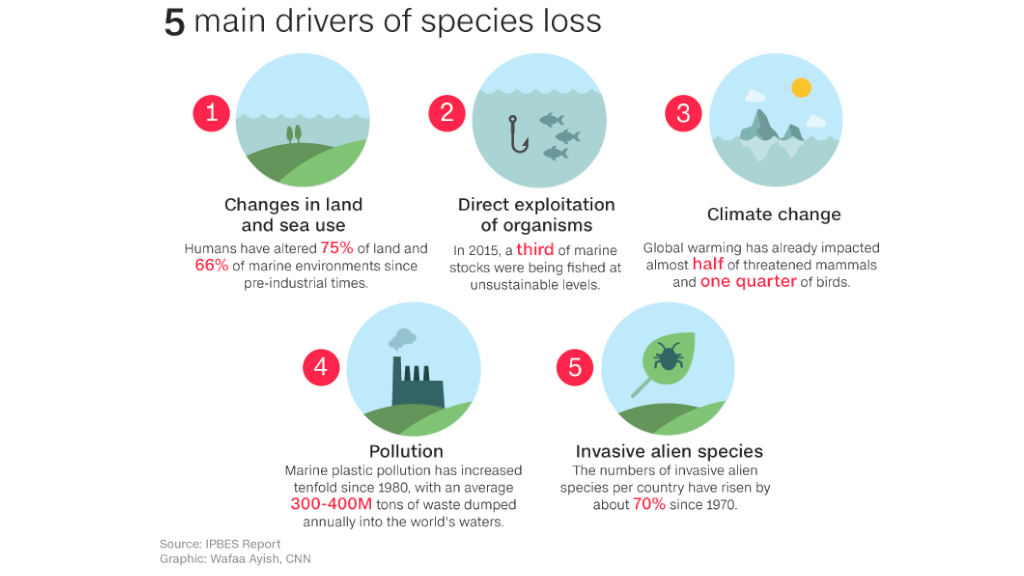Our War Against the Natural World
May 8th, 2019 | By admin | Category: Biodiversity/ConservationBy Suzanne York.
It’s the type of story that should lead the news headlines all week. But a report of critical significance for the entire world barely elicited a whimper from media, much less governments.
The Intergovernmental Science-Policy Platform on Biodiversity and Ecosystem Services was compiled over the past three years by 145 expert authors from 50 countries, with inputs from another 310 contributing authors.The findings should stop anyone in their tracks:
- Up to 1 million: species threatened with extinction, many within decades;
- 75%: terrestrial environment “severely altered” to date by human actions (marine environments 66%);
- +/-60 billion: tons of renewable and non-renewable resources extracted globally each year, up nearly 100% since 1980;
- 15%: increase in global per capita consumption of materials since 1980;
- 55%: ocean area covered by industrial fishing;
- 50%: agricultural expansion that occurred at the expense of forests;
- +/-17,000: large-scale mining sites (in 171 countries), mostly managed by 616 international corporations.
The Stark Reality We Face
Robert Watson, the chair of the IBPES didn’t mince words, saying “The health of the ecosystems on which we and other species depend is deteriorating more rapidly than ever. We are eroding the very foundations of economies, livelihoods, food security, health and quality of life worldwide. We have lost time. We must act now.”
If we only consider what this means for humans, it is chilling. Over 3 billion people rely on fish for almost 20 percent of their animal protein intake. And of course we wipe out species of flora and fauna that we already rely upon for medicinal value, and others that we don’t even yet know that could save us from many diseases.
In other related news, giraffes have been put on the endangered species, after a 41% decrease in their numbers in the past 30 years. Bengal tigers, too, are on the brink of extinction; with just 4,000 left in the wild, they could be gone by 2070, according to a new report in the journal Science Direct. A leading entomologist issued a warningthis week that we must save insects, if we are to save ourselves. The list goes on and on.
Despite the chilling statistics, it’s likely only a small number will be moved to take action. Movements such as Extinction Rebellion and climate and dedicated environmental activists like Greta Thurnberg, Jane Goodall and David Attenborough are undertaking efforts to change this, but it is an uphill climb. Perhaps people will wake up when our backs are up against the wall. Which basically means our survival as a species.
Humans are part of the web of life. Sadly, as a species we may only realize that after we’ve annihilated the rest of nature.
Ways Forward
To change the picture depends upon people altering how they interact with nature. But first, we have to start having a relationship with nature. That is one of the main problems. Too many people don’t spend time outdoors, don’t know where their food comes from, and don’t know how their (over) consumption affects the environment.
Movements such as rights of nature and Nature Needs Half offer paths forward. The first is grounded in the indigenous concept of respecting nature and wanting it to thrive. The second is an all out effort to save what remains of the natural world.
Making the connection between conservation and health through the Population, Health and Environment development model is another way to support empowering communities and protect ecosystems. This is an integrated approach linking family planning, health and conservation that recognizes the interconnectedness of people, their health and their local environment.
Lastly, we need to acknowledge that the global economic system is the driving force behind almost all of the threats to nature. There are many alternative economic systems in existence to guide us out of the current perpetual growth model.
The clock is ticking and even the best of efforts may not be enough. Yet we must do all we can to stem the tide of extinction. Young people across the globe are stepping up and protesting. Let’s support them and all who are working to protect nature. In the end, we must save Nature if we are to save ourselves.
Suzanne York is Director of Transition Earth.

![Endangered young white rhino in Uganda [photo: Suzanne York]](http://populationgrowth.org/wp-content/uploads/2019/05/Baby-rhino-300x228.jpg)

![Giraffes in Murchison Falls National Park, Uganda [photo: Suzanne York]](http://populationgrowth.org/wp-content/uploads/2019/05/Giraffes-300x254.jpg)